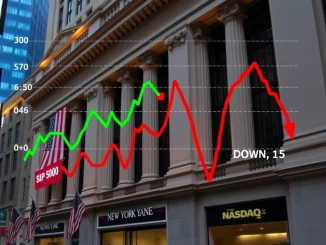
Brace yourselves, investors! The stock market landscape is flashing red as Nasdaq futures are currently experiencing a significant downturn. According to the latest data from Yahoo Finance, Nasdaq futures have tumbled to $16,823.75, marking a concerning 2.44% stock market decline over the last 24 hours. This sudden dip has sent ripples through the financial world, leaving many wondering about the potential implications and what steps to take next. Let’s dive deep into what’s happening and what it could mean for your investments.
Decoding the Stock Market Decline: What’s Behind the Nasdaq Futures Drop?
A 2.44% drop in Nasdaq futures is not just a minor fluctuation; it’s a noteworthy event that signals potential shifts in market sentiment. But what exactly fuels such a significant stock market decline? Here are a few key factors that could be at play:
- Economic Indicators: Recent economic data releases, such as inflation figures, job reports, or GDP growth, can heavily influence investor confidence. Negative or weaker-than-expected data often triggers sell-offs, leading to declines in futures markets.
- Interest Rate Hikes: Anticipation or actual increases in interest rates by central banks like the Federal Reserve can make borrowing more expensive for companies and reduce consumer spending. This can dampen economic growth prospects and negatively impact stock valuations, especially in growth-heavy sectors like tech, which are heavily represented in the Nasdaq.
- Geopolitical Uncertainty: Global events such as political instability, international conflicts, or trade tensions can create significant market volatility. These uncertainties make investors risk-averse, often leading them to move away from stocks and towards safer assets.
- Earnings Season and Corporate Guidance: If major companies within the Nasdaq composite release disappointing earnings reports or provide weak future guidance, it can trigger a broad market sell-off. Investors react to perceived risks to future profitability and growth.
- Profit Taking and Market Correction: After periods of sustained market gains, investors may engage in profit-taking, selling off assets to secure their returns. This can sometimes initiate a broader market correction, leading to a stock market decline.
Navigating Market Volatility: Understanding Futures Trading
Futures contracts are agreements to buy or sell an asset at a predetermined future date and price. Nasdaq futures specifically represent contracts based on the Nasdaq 100 index, which is heavily weighted towards technology companies. Understanding futures is crucial for grasping market sentiment because they often act as leading indicators. Here’s a breakdown:
| Aspect | Description |
|---|---|
| Futures Contracts | Agreements to buy or sell an asset (like the Nasdaq 100 index) at a future date and price. |
| Leading Indicators | Futures markets often reflect investor expectations and sentiment before the actual stock market opens. A decline in futures can foreshadow a potential drop in the cash market. |
| Leverage | Futures trading involves leverage, meaning traders control large positions with relatively smaller amounts of capital. This amplifies both potential gains and losses, contributing to market volatility. |
| 24/7 Trading | Futures markets often trade outside of regular stock market hours, providing continuous insights into global market sentiment. |
Investment Risks and Opportunities: What Does This Mean for Your Portfolio?
A significant stock market decline like this can understandably trigger concerns among investors. However, it’s essential to maintain a balanced perspective and consider both the risks and potential opportunities that arise during periods of market volatility.
Potential Risks:
- Portfolio Value Erosion: A direct and immediate risk is the decrease in the value of your stock portfolio, particularly if you hold investments heavily weighted in Nasdaq-listed companies or tech stocks.
- Emotional Reactions: Market volatility can lead to emotional decision-making, such as panic selling, which can lock in losses. It’s crucial to avoid impulsive reactions driven by fear.
- Economic Slowdown Concerns: A sustained stock market decline can sometimes reflect or even contribute to broader economic slowdown concerns, impacting overall economic health.
Potential Opportunities:
- Buying Opportunities: Market dips can present opportunities to buy into quality stocks at discounted prices. For long-term investors, these periods can be strategic entry points.
- Portfolio Rebalancing: Market volatility provides a chance to re-evaluate and rebalance your portfolio. You can adjust asset allocations to align with your risk tolerance and long-term financial goals.
- Diversification Focus: Downturns highlight the importance of diversification. Ensuring your portfolio is spread across different asset classes and sectors can help mitigate risks during market volatility.
Trading Outlook and Actionable Insights: Navigating the Downturn
So, what should investors do in light of this stock market decline and increased market volatility? Here are some actionable insights for navigating this period and shaping your trading outlook:
- Stay Calm and Avoid Panic Selling: Emotional decisions are often detrimental during market downturns. Stick to your long-term investment strategy and avoid impulsive selling.
- Review Your Portfolio: Assess your current portfolio allocation and understand your exposure to Nasdaq-related assets. Determine if adjustments are needed based on your risk tolerance.
- Consider Dollar-Cost Averaging: If you have cash on hand, consider dollar-cost averaging, which involves investing a fixed amount of money at regular intervals. This strategy can help reduce the risk of investing a lump sum at the wrong time during volatile periods.
- Focus on Long-Term Fundamentals: Instead of getting caught up in short-term market fluctuations, focus on the long-term fundamentals of the companies you invest in. Strong businesses with solid growth prospects are more likely to weather market storms.
- Seek Professional Advice: If you’re unsure how to navigate the current market volatility, consider consulting with a financial advisor who can provide personalized guidance based on your financial situation and goals.
In Conclusion: Staying Informed and Prepared
The 2.44% drop in Nasdaq futures serves as a stark reminder of the inherent market volatility and investment risks in the financial world. While such declines can be unsettling, they also present opportunities for informed and prepared investors. By understanding the factors driving stock market decline, recognizing the nature of futures trading, and adopting a strategic trading outlook, you can navigate these turbulent times with greater confidence and potentially position your portfolio for long-term success. Stay informed, stay rational, and remember that market cycles are a natural part of the investment journey.



